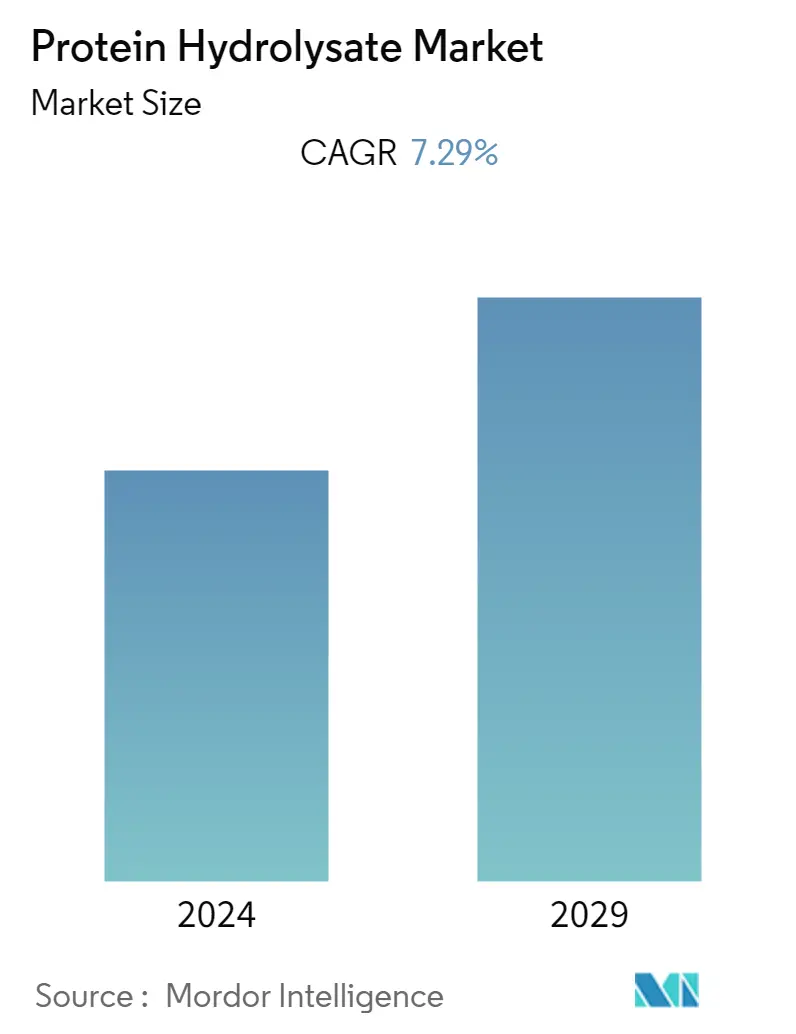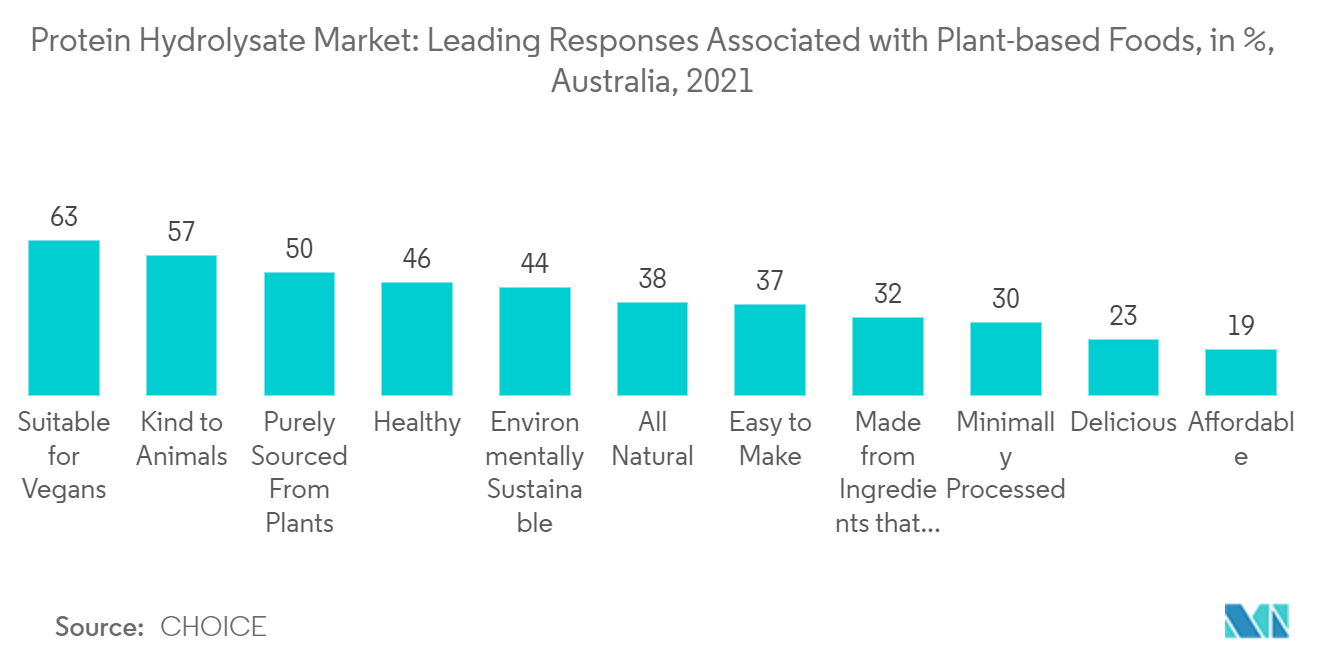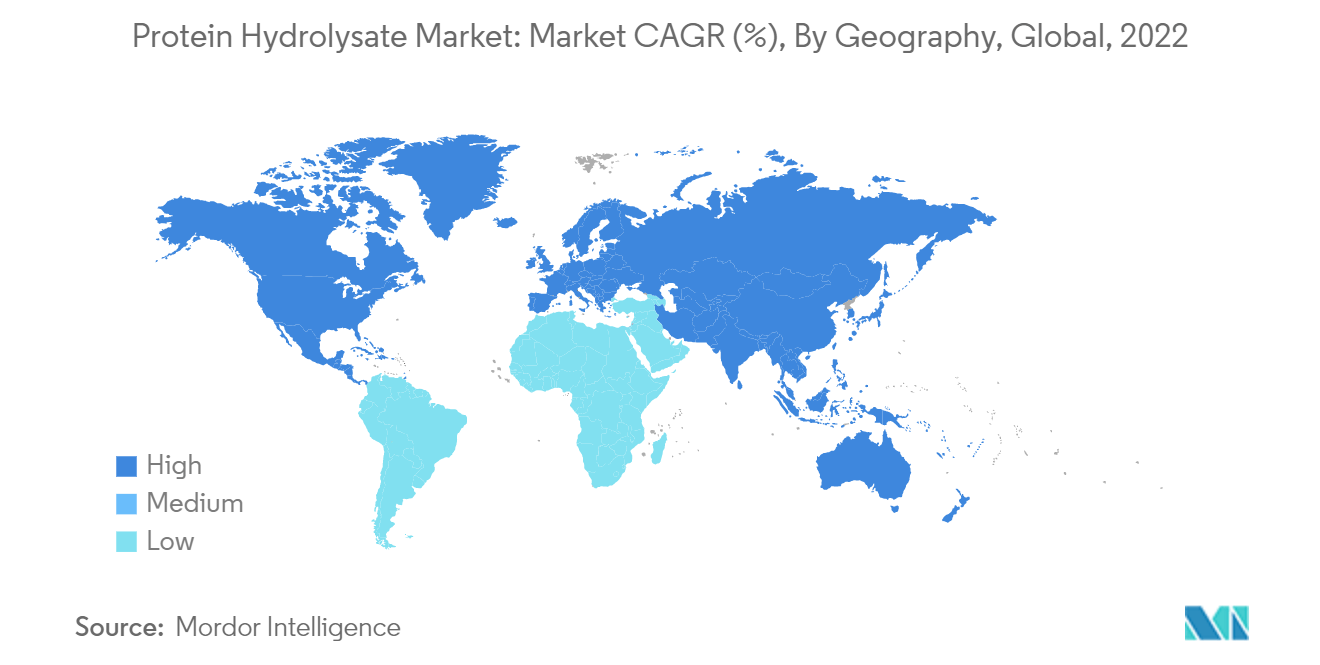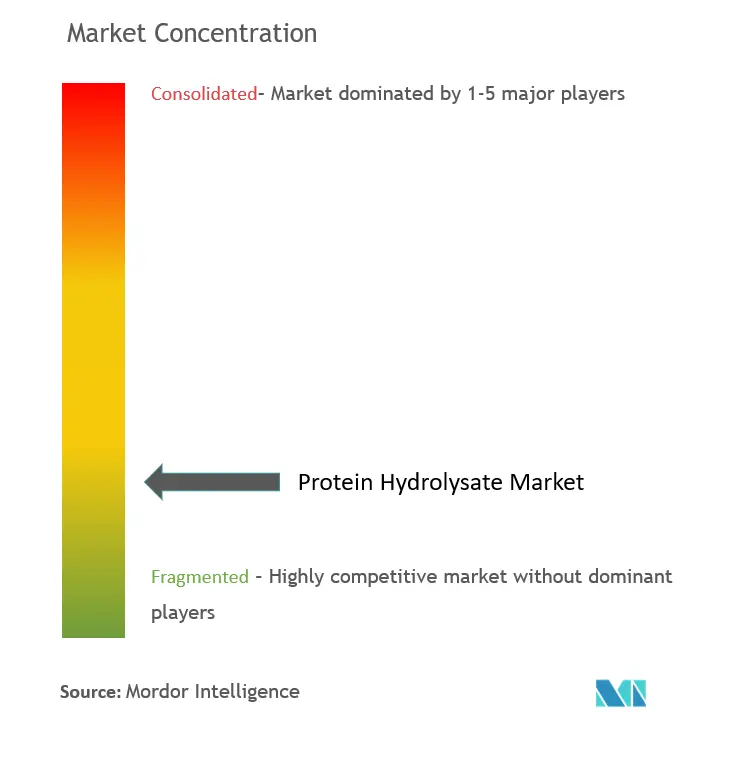Protein Hydrolysate Market Size

| Study Period | 2019 - 2029 |
| Base Year For Estimation | 2023 |
| CAGR | 7.29 % |
| Fastest Growing Market | Asia-Pacific |
| Largest Market | Asia Pacific |
| Market Concentration | Low |
Major Players.webp)
*Disclaimer: Major Players sorted in no particular order |
Protein Hydrolysate Market Analysis
The Protein Hydrolysate Market is expected to register a CAGR of 7.29 % during the forecast period.
The demand for protein hydrolysates has been growing in recent years due to the increasing popularity of sports nutrition products, as well as the rising awareness among consumers about the health benefits of protein. Protein hydrolysates are commonly used as ingredients in sports drinks, protein bars, and supplements, as they are highly bioavailable and can help to support muscle growth and recovery.
Additionally, it is also driven by the increasing demand for infant nutrition owing to its overall nutrition enhancement, reduce risk of allergies, and improved protein digestibility. Hydrolyzed milk protein digest faster than milk protein isolates. Owing to its easy digestibility, hydrolyzed milk protein is the most used ingredient by infant food manufacturers. Thereby, the growing demand for hydrolyzed milk protein in the nutraceutical industries is further driving the growth of the market. The milk proteins are hydrolyzed using enzymes to decrease the allergenicity, increase adsorption and improve the functional properties of proteins for their end-use application. In line with this, hydrolyzed milk protein has been used in nutritional beverages owing to its increased rate of absorption. Similarly, it is used in the production of cheese and yogurts as it helps to improve the gel strength of the product. Hence, the growing consumption of hydrolyzed milk protein in the dairy product industry is accelerating the growth of the market.
Furthermore, the high purity, bioavailability, and digestibility of protein hydrolysate, as compared to other forms of protein, i.e., isolates and concentrates, are among the significant properties that boost their demand. Consumers who exercise seriously have a positive perception of protein hydrolysates and a sound awareness of their benefits. This is popularizing the protein hydrolysate ingredients.
Protein Hydrolysate Market Trends
Rise in Popularity of Vegan Diet
With modified technologies, companies target consumers by producing innovative products with organoleptic properties similar to real meat. These ingredients are made with a combination of protein hydrolysate to attain the desired flavor and taste. The new compositional research and modified high-technological process are helping grow the plant-based protein hydrolysate market. Clean eating, environmental/sustainability reasons, and better treatment of animals are some factors spurring the demand. As most athletes and active consumers seek alternative products while cutting their requirement on animal protein, a load up on products made from old standbys including pea, rice, hemp, and soy, have gained importance lately. Furthermore, a set of newer unique proteins, including sacha inchi, quinoa, and water lentil are appearing with greater frequency in protein blends. Yet, their efficacy for supporting muscle building is not noticeable.
Soy protein ingredients expanded from mainstream application areas and key companies, such as Archer Daniels Midland Company, Cargill Incorporated, and IFF's (DuPont Inc.), embarked on intense mergers and acquisitions to strengthen the consolidation of the plant protein hydrolysates industry. Soy products have a long history in milk replacer formulations. Their popularity stems from their widespread availability, competitive cost, and favorable amino acid profile. Soy protein concentrate (SPC) and soy flour (SF) are the most common soy proteins used in milk replacers. Additionally, in a study conducted in 2021 by Choice Australia, 63% of participants said they thought items with the designation "plant-based" were appropriate for vegans. Plant-based foods were more frequently associated by respondents with sustainability, animal friendliness, and health, but less frequently with deliciousness or affordability. Hence, the inclination towards a vegan diet is expected to propel the market during the forecast period.

Asia-Pacific Drives Protein Hydrolysate Market
Asia-Pacific holds the largest share due to the increased demand for nutritional food among consumers. The market for protein hydrolysate ingredients is expected to grow, owing to consumer health consciousness, bolstered by the aging population and a growing desire to prevent or manage age-related health conditions through nutrition. With a growing number of vegetarian populations, plant protein hydrolysate ingredients, such as soy protein hydrolysates, hold a dominant share in the Indian market. Increasing awareness about vegan snacks, with their high nutritional profile, is one of the key factors impacting the soy protein ingredients market, including soy protein hydrolysates, in the region.
An increase in the quality of lifestyle of middle-income and lower-income families, a high rate of urbanization, and increasing health awareness would be major drivers for the growth of the protein hydrolysates market across the region. Additionally, according to data published by the Australian Sports Commission, approximately 49.1% of Australians between the ages of 18 and 24 used gyms, fitness clubs, or sports or recreation facilities in Australia during the 2022 fiscal year. The involvement rate was also high for persons in the 25 to 35 age range, but it appeared to be decreasing with age for those beyond 35. Furthermore, the ongoing fitness trend across the region is also expected to drive the market as protein hydrolysates might stimulate the synthesis of muscle protein.

Protein Hydrolysate Industry Overview
The protein hydrolysate market is a fragmented one with a huge number of players operating in the market hence, the players have been competing to gain more market shares in the domestic as well as international protein hydrolysate market. Some of the major players in the market include Arla Foods Amba, Fonterra Co-Operative Group Limited, Kerry Group PLC, Glanbia PLC, and Kerry Group. Companies have been using various strategies to penetrate the market studied. Some key strategies the leading players use include focusing on new product launches with healthier ingredients/organic claims, acquisitions, mergers, partnerships, and expansions. With increasing health consciousness, major players adopt strategies to draw consumers' attention by introducing dairy ingredients with clinical claims, such as organic, clean-label, non-GMO certified, etc. For example, the milk powders offered by Fonterra Co-Operative Group Limited are claimed to be clean of artificial ingredients.
Protein Hydrolysate Market Leaders
-
Arla Foods amba
-
Royal FrieslandCampina N.V.
-
Fonterra Co-operative Group Limited
-
Kerry Group PLC
-
Glanbia PLC
*Disclaimer: Major Players sorted in no particular order

Protein Hydrolysate Market News
- May 2022: Kerry Group opened a new EUR 38 million manufacturing plant in KwaZulu-Natal, South Africa. The 10,000-square-metre plant produces nutrition products to be consumed across Africa.
- November 2021: Groupe Lactalis inaugurated its new whey drying tower in its factory based in Verdun, France. This new tower, equipped with the latest drying technologies, allows the production of 30,000 tons of whey powder intended for the food industry.
- June 2021: A new whey protein hydrolysate component from Arla Foods Ingredients was introduced WPH Lacprodan DI-3091 in the market. The ingredient was intended to help patients with maldigestion or malabsorption overcome taste problems.
Protein Hydrolysate Market Report - Table of Contents
1. INTRODUCTION
1.1 Study Assumptions and Market Definition
1.2 Scope of the Study
2. RESEARCH METHODOLOGY
3. EXECUTIVE SUMMARY
4. MARKET DYNAMICS
4.1 Market Drivers
4.2 Market Restraints
4.3 Porter's Five Forces Analysis
4.3.1 Threat of New Entrants
4.3.2 Bargaining Power of Buyers/Consumers
4.3.3 Bargaining Power of Suppliers
4.3.4 Threat of Substitute Products
4.3.5 Intensity of Competitive Rivalry
5. MARKET SEGMENTATION
5.1 Source
5.1.1 Plant Protien
5.1.2 Animal Protien
5.2 Form
5.2.1 Liquid
5.2.2 Dry
5.3 Application
5.3.1 Sports Nutrition
5.3.2 Dietary Supplements
5.3.3 Food Products
5.3.4 Others
5.4 Geography
5.4.1 North America
5.4.1.1 The United States
5.4.1.2 Canada
5.4.1.3 Mexico
5.4.1.4 Rest of North America
5.4.2 Europe
5.4.2.1 Spain
5.4.2.2 United Kingdom
5.4.2.3 Germany
5.4.2.4 France
5.4.2.5 Italy
5.4.2.6 Russia
5.4.2.7 Rest of Europe
5.4.3 Asia Pacific
5.4.3.1 China
5.4.3.2 Japan
5.4.3.3 India
5.4.3.4 Australia
5.4.3.5 Rest of Asia-Pacific
5.4.4 South America
5.4.4.1 Brazil
5.4.4.2 Argentina
5.4.4.3 Rest of South America
5.4.5 Middle-East Africa
5.4.5.1 South Africa
5.4.5.2 United Arab Emirates
5.4.5.3 Rest of Middle-East and Africa
6. COMPETITIVE LANDSCAPE
6.1 Strategies Adopted by Leading Players
6.2 Market Share Analysis
6.3 Company Profiles
6.3.1 AMCO Proteins
6.3.2 Arla Foods amba
6.3.3 Griffith Foods Inc.
6.3.4 Kerry Group PLC
6.3.5 Tate & Lyle PLC
6.3.6 Koninklijke DSM N.V.
6.3.7 Glanbia PLC
6.3.8 Royal FrieslandCampina N.V.
6.3.9 Fonterra Co-operative Group Limited
6.3.10 Groupe Lactalis
- *List Not Exhaustive
7. MARKET OPPORTUNITIES AND FUTURE TRENDS
Protein Hydrolysate Industry Segmentation
Hydrolyzed protein is a solution derived from the hydrolysis of a protein into its component amino acids and peptides. The global protein hydrolysate market is segmented by source, form, application, and geography. By source, the market is segmented into plant and animal. By form, the market is bifurcated into dry and liquid forms. Based on the application, the market is segmented into sports nutrition, dietary supplements, food products, and others. The geographical analysis includes regions such as North America, Europe, Asia-Pacific, South America, and the Middle East and Africa. The market sizing has been done in value terms in USD for all the abovementioned segments.
| Source | |
| Plant Protien | |
| Animal Protien |
| Form | |
| Liquid | |
| Dry |
| Application | |
| Sports Nutrition | |
| Dietary Supplements | |
| Food Products | |
| Others |
| Geography | |||||||||
| |||||||||
| |||||||||
| |||||||||
| |||||||||
|
Protein Hydrolysate Market Research FAQs
What is the current Protein Hydrolysate Market size?
The Protein Hydrolysate Market is projected to register a CAGR of 7.29% during the forecast period (2024-2029)
Who are the key players in Protein Hydrolysate Market?
Arla Foods amba, Royal FrieslandCampina N.V., Fonterra Co-operative Group Limited, Kerry Group PLC and Glanbia PLC are the major companies operating in the Protein Hydrolysate Market.
Which is the fastest growing region in Protein Hydrolysate Market?
Asia-Pacific is estimated to grow at the highest CAGR over the forecast period (2024-2029).
Which region has the biggest share in Protein Hydrolysate Market?
In 2024, the Asia Pacific accounts for the largest market share in Protein Hydrolysate Market.
What years does this Protein Hydrolysate Market cover?
The report covers the Protein Hydrolysate Market historical market size for years: 2019, 2020, 2021, 2022 and 2023. The report also forecasts the Protein Hydrolysate Market size for years: 2024, 2025, 2026, 2027, 2028 and 2029.
Protein Hydrolysate Industry Report
Statistics for the 2024 Protein Hydrolysate market share, size and revenue growth rate, created by ����vlog��ý™ Industry Reports. Protein Hydrolysate analysis includes a market forecast outlook to 2029 and historical overview. Get a sample of this industry analysis as a free report PDF download.



